In-Depth
Configuring and Using SharePoint 2013 for a Social Enterprise
Here's how to implement the new social networking features in the latest version of the Microsoft collaboration and content management platform.
When Microsoft released SharePoint 2013 late last year, it became clear that social business is the new normal -- and SharePoint can be your organization's social hub.
Put aside the fact that Microsoft last year acquired enterprise social networking site Yammer for $1.2 billion and is on a path to tie it with SharePoint and Microsoft's other wares ranging from SkyDrive to Dynamics. SharePoint 2013 introduces Community Sites and My Sites, which provide a social interface for internal business collaboration, but are also designed to leverage the security and other business and enterprise management features of SharePoint. This is a natural extension of collaboration among workgroups and partners.
"[Chief Digital Officers] are looking at social in terms of being able to close the gap between strategy and execution, execution and measurement, and measurement and strategy," social business analyst R. "Ray" Wang told the MIT Sloan Management Review. Wang, who is CEO of Constellation Research Inc., believes CTOs understand that SharePoint can be the platform to integrate these technologies and bring innovation in-house -- provided there's a social business strategy and plan.
I'll look in-depth at three social aspects of SharePoint 2013 -- Community Sites, My Sites and the new Newsfeed -- that set SharePoint 2013 apart from its predecessors and make upgrading a smart and forward-thinking decision.
Community Sites
For many of you, your most vivid memories of SharePoint consist of images of a hard-working, collaborative team and some document libraries -- also known as the Team Site (see Figure 1).
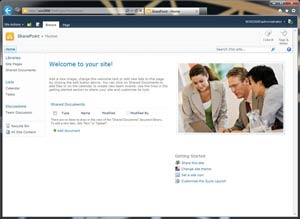 [Click on image for larger view.]
Figure 1. The Team Sites interface before Microsoft updated it.
[Click on image for larger view.]
Figure 1. The Team Sites interface before Microsoft updated it.
So, what's changed? Enter Team Site's more social sibling, the Community Site (see Figure 2).
 [Click on image for larger view.]
Figure 2. Community Sites display discussions and provide access to relevant information.
[Click on image for larger view.]
Figure 2. Community Sites display discussions and provide access to relevant information.
Unlike other SharePoint site templates, the Community Site relies on user-generated content in the form of threaded and categorized discussions. Top contributors are automatically featured on the community homepage, ranked not only by their number of posts but also by the value of those posts.
Creating a new Community Site is simple: select Community Site from the list of Collaboration site templates available in SharePoint (see Figure 3).
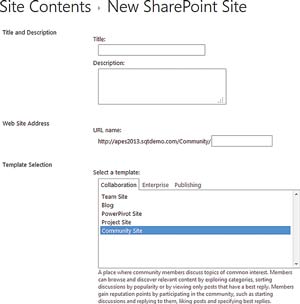 [Click on image for larger view.]
Figure 3. The interface to create a new Community Site displays key setup parameters.
[Click on image for larger view.]
Figure 3. The interface to create a new Community Site displays key setup parameters.
Depending on the business role of the community, site owners can select one of four permissions levels for Community Sites:
- Private: Only selected members can see or interact with the community.
- Closed: End users can read content, but only members who receive approved requests can contribute content.
- Open with explicit membership: End users can read content and join the community automatically to contribute content.
- Open: Anyone can contribute content.
The Community Site template, like other SharePoint subsites, can inherit or disinherit permissions from the parent site. The basic permissions and security constructs stay the same -- Community Sites simply build on this construct using the permissions levels previously described. Despite this architecture, it's considered a better practice to use unique permissions to manage community membership, and organizations using communities at the site level will need to be aware of this setup.
There's nothing stopping the Community Site owner from adding apps to extend the base capabilities of the Community Site. For communities where document libraries, task lists, calendars, wikis, and more are desired or necessary, app addition mimics the Team Site and publishing site models.
But the key feature in Community Sites isn't the discussion list, which is really just a retooled and updated version of a feature already introduced in previous generations of SharePoint. And it's not the out-of-the-box capture and display of top community contributors. The key to the Community Site's adoption lies in its built-in moderation capabilities.
Many organizations are understandably reluctant to turn content creation over to the masses. But the thought becomes more palatable when management and moderation are in the hands of not only the site owners, but trusted site advisers assigned by the organization.
Community moderators have access to features that enable them to more effectively follow discussions, such as:
- Offensive content reporting: This is probably the most useful tool as it doesn't require constant vigilance on the part of the moderator; rather it relies on the community policing model that's common practice in well-run online communities. You can allow users to report offensive or inappropriate content in the community with a simple community settings configuration change (see Figures 4 and 5).
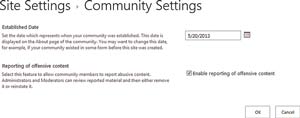 [Click on image for larger view.]
Figure 4. Rather than requiring a moderator, site administrators can set up an alerting mechanism.
[Click on image for larger view.]
Figure 4. Rather than requiring a moderator, site administrators can set up an alerting mechanism.
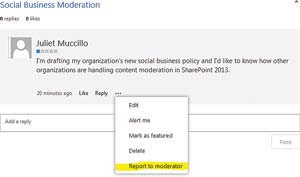 [Click on image for larger view.]
Figure 5. The user can flag offensive content by clicking "Report to moderator."
[Click on image for larger view.]
Figure 5. The user can flag offensive content by clicking "Report to moderator."
- Alerts: While the alerts aren't new, they're a moderator's best friends. Moderators can, and should, subscribe to discussion list alerts via e-mail or -- better yet -- text message. For active communities immediate alerts might be a bit much, but daily and weekly digest options are still available and easily configured.
Community managers know community moderation isn't always about being the bad cop. Most communities find their way surprisingly quickly to the community policing model. If you're skeptical, consider this: Have you ever ordered from a one-star seller on eBay? Probably not.
Community Sites give the moderator more time to actually build the community content and reward the community's best and brightest. SharePoint 2013 lets moderators manage and expand the reputation of the community members. Moderators can promote discussion threads to "featured" status, grant "badges" to outstanding contributors for consistent and relevant posting, and organize content tags.
The moderator is critical to the success of Community Sites. The Community Site's value is only as strong as the human interaction behind the site. For those of you involved in the strategic outlay of these new technologies, take care to be well-versed in the human resources costs associated with integrating new features into your SharePoint implementations.
Architecture for Community Sites
Architecturally speaking, setting up your community portal involves only a few critical decisions:
- Think scale. If you can get these communities rolling and producing content, they're going to become big quickly. If there's a case for isolating communities into their own site collection, don't think twice, just do it. Scale the solution now -- you'll thank yourself later.
- Think services. For communities to work efficiently, users must be able to access each other's profiles, tag content and use search. According to the Microsoft TechNet Library page, "Overview of communities in SharePoint 2013", the user profile service application, social and profile databases, managed meta-data service, search service, and databases are all optional when implementing a community solution -- and technically they are -- but implementing the Community Sites minus the profile and personalization features that accompany them can be catastrophic for user adoption.
For many organizations, SharePoint 2013 Community Sites will be less about technical implementation and more about strategy and execution. Community management is an obvious addition to any SharePoint governance plan, and governance committees will need to ask (and answer) the following questions:
- Are SharePoint communities in line with our larger social business strategy?
- Who can create communities?
- What are our policies around assigning moderators?
- When do communities "close"?
- When do we create Community Sites versus Team Sites or publishing sites?
Though the idea of community is inextricably intertwined with the meaning of social, some organizations may choose to take a more "me"-centered approach. Extended My Sites capabilities and the new Newsfeed offer social capabilities without the extensive site management required to run successful communities.
The 'Me' in My Sites
When I build SharePoint intranets for clients, the No. 1 sentiment I hear during the UX and interviewing phase is, "I don't really care about other people's stuff, or really even company stuff. I just want what's interesting to me and relevant to my job right there on the homepage." There's technology at your users' fingertips every day -- why should you expect, or want, your company's employees to wade through libraries of irrelevant information just to get to one important document? It's a waste of efficiency.
SharePoint 2013 My Sites have the ability to give users exactly what they want -- quick access to "their stuff."
A user now has the ability to "follow" sites, documents or people. The "following" mechanism automatically creates lists for a user that are rendered in his My Site, both on the My Sites homepage and the Newsfeed page.
My Sites give a user one-click access to sites she follows and, based on various criteria, recommend other sites she might find useful or interesting (see Figure 6) -- providing her permissions give her access to those sites.
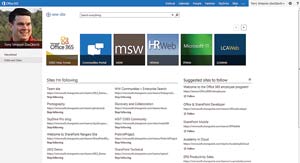 [Click on image for larger view.]
Figure 6. The user can view SharePoint sites he's following, while also seeing suggested relevant sites to follow.
[Click on image for larger view.]
Figure 6. The user can view SharePoint sites he's following, while also seeing suggested relevant sites to follow.
But following doesn't just allow a user to build personalized site navigation. It also allows him to create a site driven mainly by the content of his choosing.
Newsfeeds are dynamically updated content generated by the activities of fellow users (see Figure 7). They embrace the now-ubiquitous hash-tags and "@ mentions," and closely resemble Twitter or Facebook feeds. Unlike in external social networks, however, organizations can exercise some control over which activities appear on the Newsfeed from within the User Profile Service Application (click here for more information).
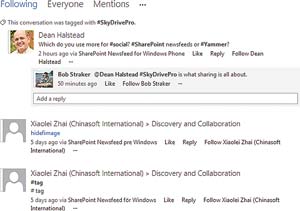 [Click on image for larger view.]
Figure 7. The SharePoint 2013 Newsfeed is familiar to those who use social networks.
[Click on image for larger view.]
Figure 7. The SharePoint 2013 Newsfeed is familiar to those who use social networks.
In the Newsfeed Settings screen, a user has considerable control over hash-tags, e-mail notifications, "People I follow" and "Activities I want to share in my Newsfeed."
For the many organizations that will feel the desire to deny users this level of flexibility, refer to the long-forgotten SharePoint 2010 Activity Feed Web Part as a cautionary tale: too limited, too little, too late.
For a me-centered user, the power of the "I'm Following" Web Part can't be overstated. With a simple four-category display, the user has everything needed to navigate efficiently to the aspects of the SharePoint site that are the most relevant to his work.
In past iterations of SharePoint, it was possible to implement Team Site functionality and virtually ignore My Sites. SharePoint 2013 makes it nearly impossible to leverage any social features and move forward with your SharePoint implementation without My Sites. It's easier to make a case for a holistic approach to SharePoint implementation that simply wasn't necessary before.
Risk vs. Reward
Intellectual property and reputation are critical, and when implementing SharePoint 2013 it's important to keep this in mind. The McKinsey Global Institute's "The Social Economy: Unlocking Value and Productivity Through Social Technologies" (a PDF can be downloaded from here) cites loss of intellectual property and reputation management, among other things, as one of the most touted risks of going social for business. However, the McKinsey report also points out that these are risks some organizations can and should be willing to take, given the dividends social can eventually pay.
Organizations can exert considerable amounts of control over their SharePoint enterprise solutions. Not only does SharePoint 2013 introduce the new moderation capabilities described in this article, it still actively incorporates approval workflows and even the expanded eDiscovery functionality, which gives records managers and legal teams the ability to discover and preserve electronic content across SharePoint sites.
Costs of Social
The enterprise architecture that's necessary to run these tools effectively isn't without cost. Beyond licensing costs, there are considerations for hardware and software, including SharePoint databases, Web front-end servers, application servers, SharePoint services and features, and architecture to support redundancy and performance.
Also critical is the hard truth that many organizations don't have the technical or the business user expertise on staff to effectively administer -- and train staff on how to use -- SharePoint efficiently.
IT Imperative
So, is the transition to SharePoint 2013 worth it? Microsoft certainly seems to think so. The company hasn't been Yammering all spring for nothing. A recent Microsoft survey compared social business tools to e-mail with regard to their capacity for increasing productivity and elevating change in an organization.
Forbes magazine recently cited two unrelated studies that indicate market trends support the move to social. Both data firm Evolv Inc.'s study and a study conducted by Warwick Business School professor Joe Nandhakumar suggest that employees who engage with social media are ultimately more in tune with each other and their clients. Additionally, younger employees expect to interact with their colleagues in more social mediums than previous generations of employees.
Leveraging the social features in SharePoint 2013 can give organizations ample control over social business interaction while still protecting content and intellectual property -- a win for both social employees and decision makers.